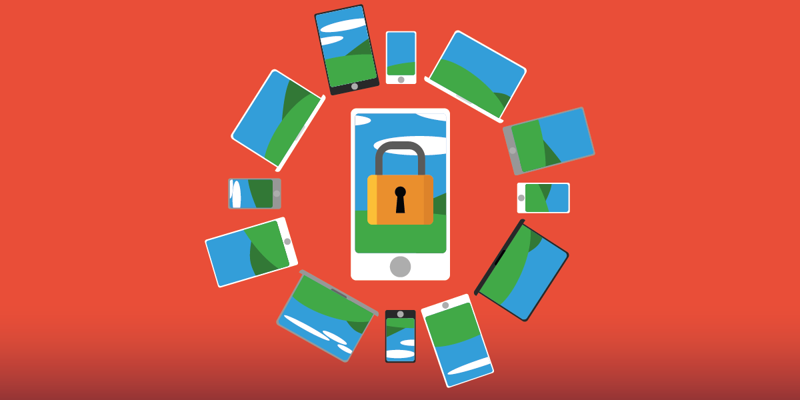What is Mobile Device Management (MDM)?
Mobile Device Management (MDM) is a software solution that allows organizations to manage, monitor, and secure mobile devices used by employees. These devices include smartphones, laptops, and tablets. MDM enables administrators to oversee device usage, monitor for suspicious activity, and enforce security measures in line with company policies, such as the Acceptable Use Policy.
With MDM, administrators can remotely install security updates, configure settings, and even wipe data from lost or stolen devices. This is especially important for preventing data breaches and ensuring compliance with regulations like GDPR. By integrating MDM into your risk assessment process, you can significantly reduce the risk of sensitive data falling into the wrong hands.
Why Mobile Device Management is Important
Mobile devices have become essential tools in the workplace, allowing employees to perform tasks on the go that were once confined to office desktops. However, this convenience comes with risks that can make any IT administrator uneasy. Concerns about unauthorized applications, insecure networks, and stolen devices accessing company data are valid and increasingly common.
MDM offers a solution to these challenges, providing IT administrators with the tools they need to manage and secure mobile devices effectively. Here’s how MDM can offer peace of mind:
Key Benefits of Mobile Device Management
Mobile Device Management provides numerous advantages, from enhancing security to simplifying IT administration. Here are some key benefits:
-
Automated Device Setup: MDM automates the configuration of devices, such as installing standard applications and setting up Wi-Fi, saving time and reducing errors.
-
Remote Device Management: If a device is lost or stolen, MDM allows you to wipe it remotely, preventing unauthorized access to your organization’s systems.
-
Enhanced Security: Enforce your IT security policies across all devices, such as requiring passcodes or encrypting sensitive data.
-
Application Control: Monitor and control which applications are installed on devices, ensuring compliance with company policies.
-
Productivity Management: Block non-work-related applications during work hours to keep employees focused and aligned with company objectives.
How to Choose an MDM System
Choosing the right MDM system requires careful consideration of your organization’s needs and goals. Here are some questions to guide you in selecting the best MDM provider:
1. Does the MDM System Fit Your Organization’s Size?
Your chosen MDM solution should scale with your organization’s needs. Consider the types and number of devices you use and whether the system can grow with your organization. Switching MDM providers can be costly and time-consuming, so it’s important to choose a scalable solution from the start.
2. Does the MDM Service Integrate with Your Existing Systems?
Ensure that the MDM system is compatible with your organization’s existing security and IT management tools. Incompatible systems can lead to increased manual work and operational inefficiencies.
3. What is the Provider’s Track Record?
Opt for an MDM provider with a proven history of delivering reliable services. Since MDM is a relatively new field, many providers are entering the market, but not all will last. Choosing an established provider reduces the risk of needing to switch services down the line.
4. What Level of Support Do You Need?
While free MDM services can be attractive, they often come with limited support. Consider your team’s ability to manage and troubleshoot the system independently. If your organization requires more comprehensive support, it may be worth investing in a paid MDM solution.
The Difference Between Mobile Device Management and Asset Management
It’s easy to confuse Mobile Device Management (MDM) with Asset Management (AM), but they serve different purposes. While MDM focuses on monitoring device usage, enforcing security policies, and remotely wiping devices, Asset Management is primarily concerned with tracking devices and their configurations. AM provides an inventory of devices and software but lacks the remote management capabilities of MDM. Implementing both MDM and AM can provide a comprehensive approach to managing your organization’s IT assets.
The Next Level of MDM: EMM and UEM
For larger organizations, MDM alone may not be sufficient to manage all digital touchpoints. In such cases, consider Enterprise Mobility Management (EMM) or Unified Endpoint Management (UEM), which offer more advanced features and integration capabilities. These solutions are more complex but provide a higher level of control across all endpoints in your organization.
Conclusion
Mobile Device Management (MDM) is a powerful tool that helps organizations manage and secure the mobile devices used by their employees. By automating device setup, enforcing security policies, and providing remote management capabilities, MDM enhances both IT efficiency and data security. When selecting an MDM system, consider your organization’s size, integration needs, the provider’s reliability, and the level of support required. While MDM and Asset Management serve different functions, together they offer a robust solution for managing your organization’s IT assets.
We hope this post has helped clarify what Mobile Device Management is and how it can benefit your organization. If you’re looking to strengthen your cybersecurity strategy, MDM is a great place to start.
People Also Asked
-
What does MDM stand for?
MDM stands for Mobile Device Management, a solution that enables organizations to oversee, regulate, and secure mobile devices used by their employees.
-
What is an MDM system?
An MDM system is software that allows businesses to manage and control mobile devices used by their employees, including features like remotely wiping data, enforcing security policies, and managing application installations.
-
Why is an MDM system important?
MDM is crucial for managing and securing employees' mobile devices, which often contain sensitive company data. It allows for remote monitoring, updating, and wiping of devices, ensuring data security and compliance with organizational policies.

